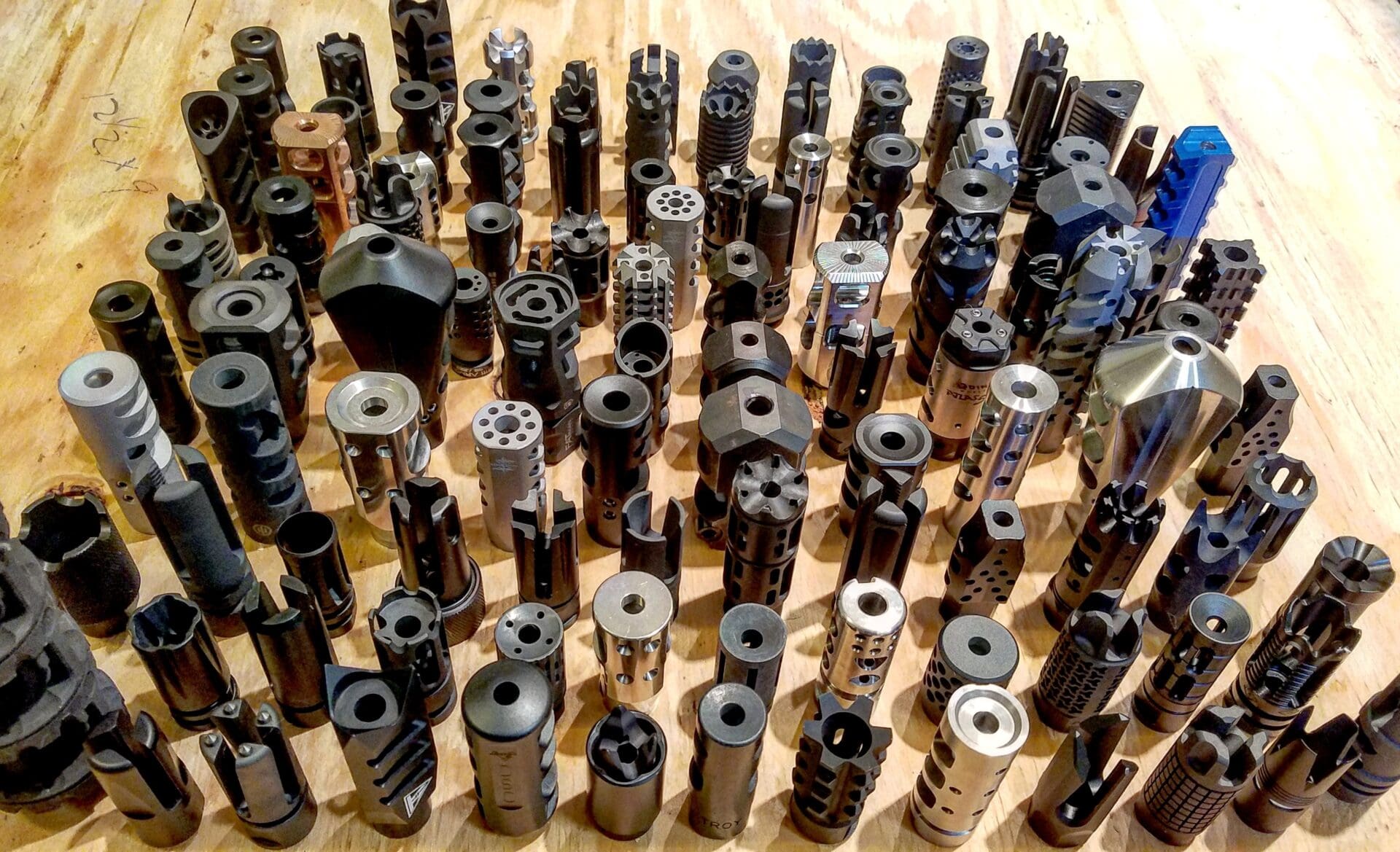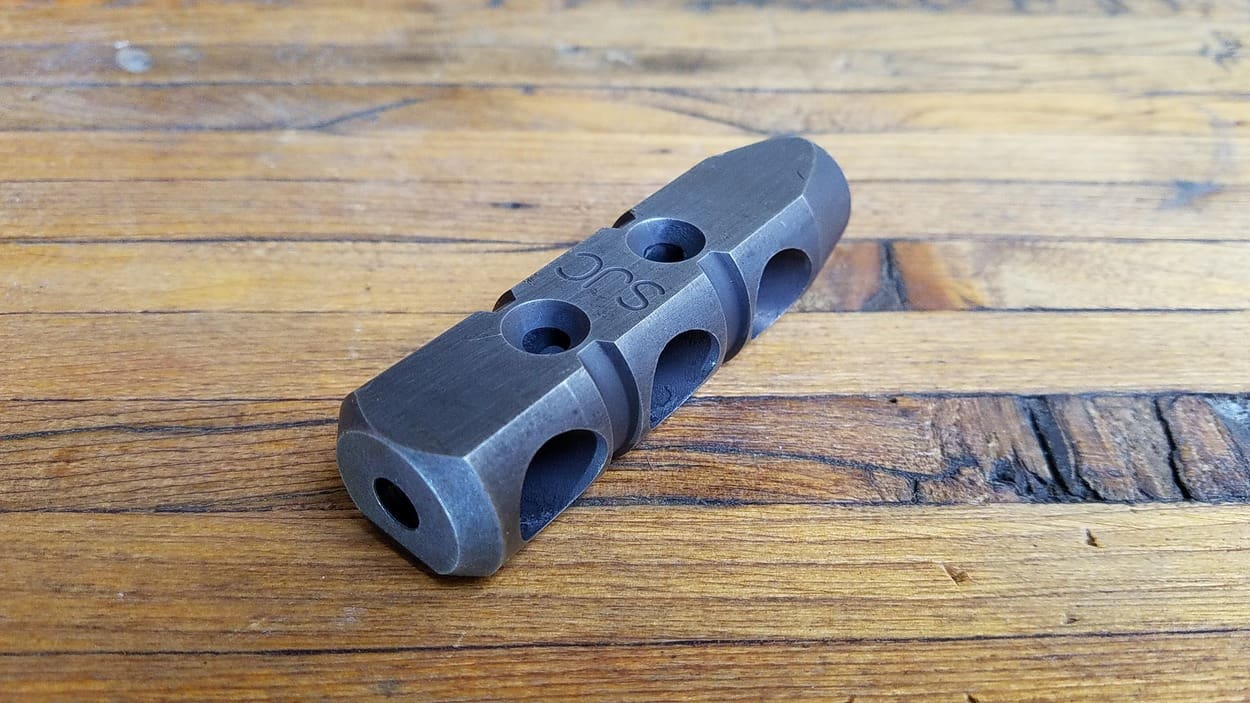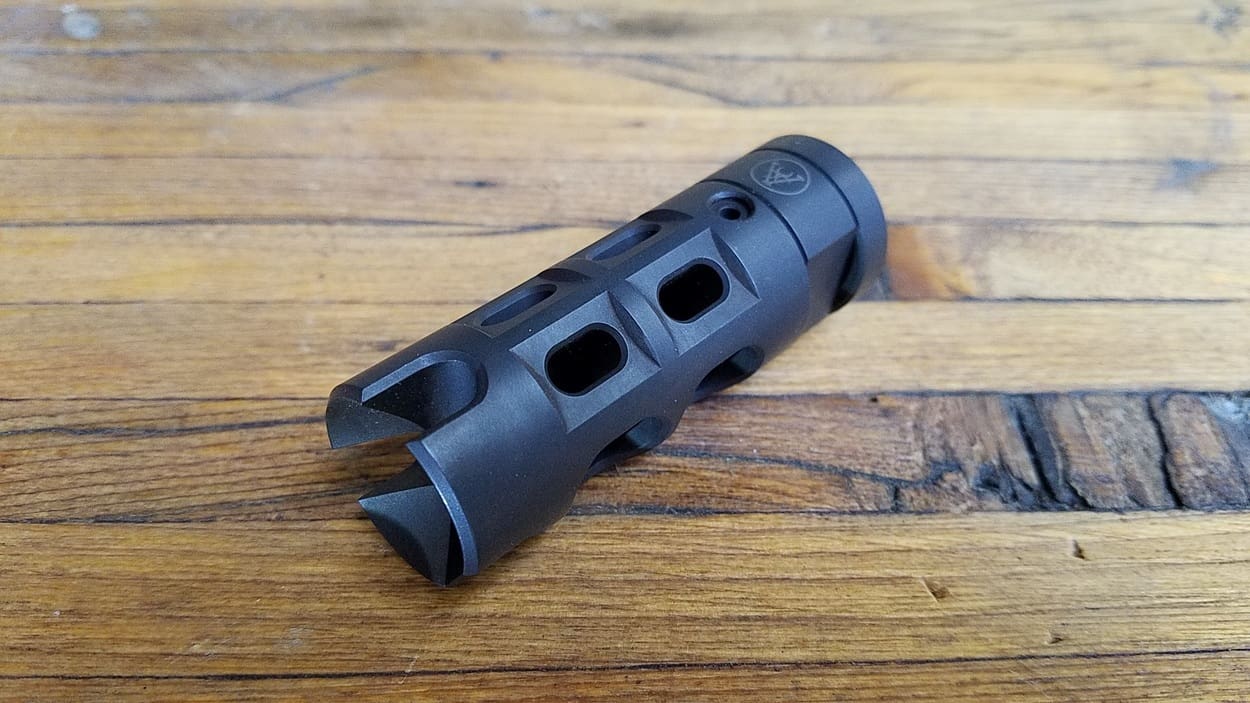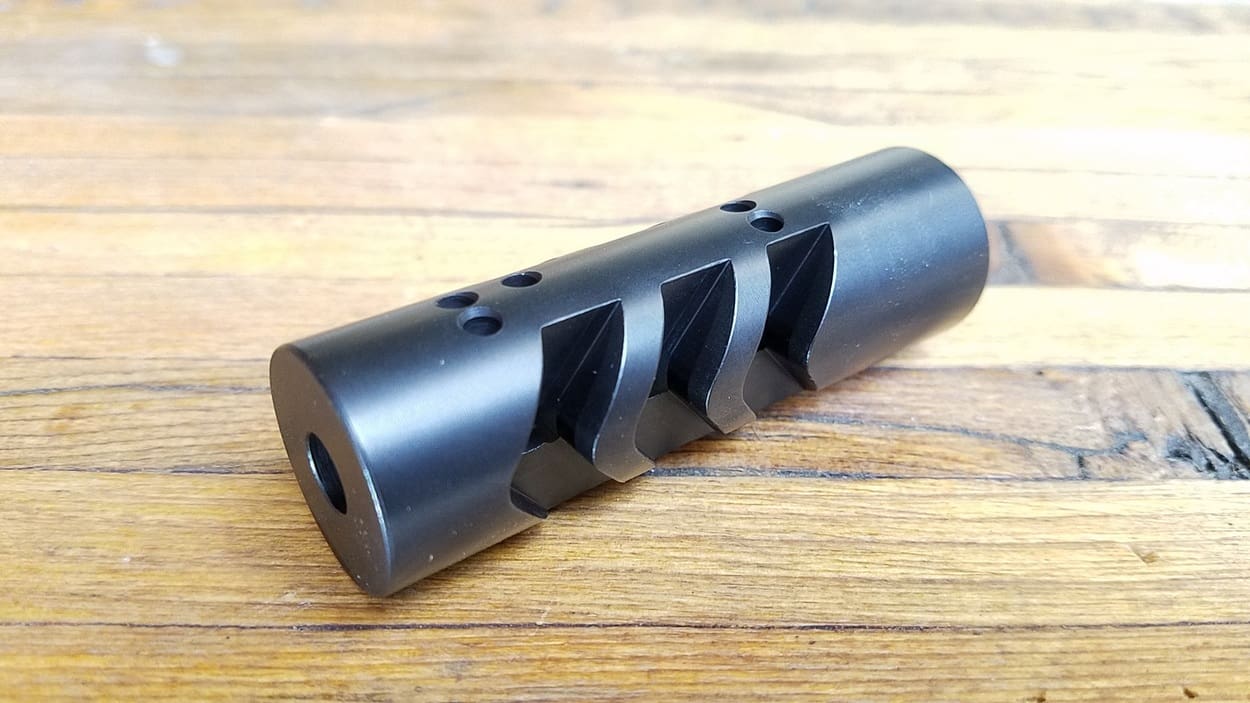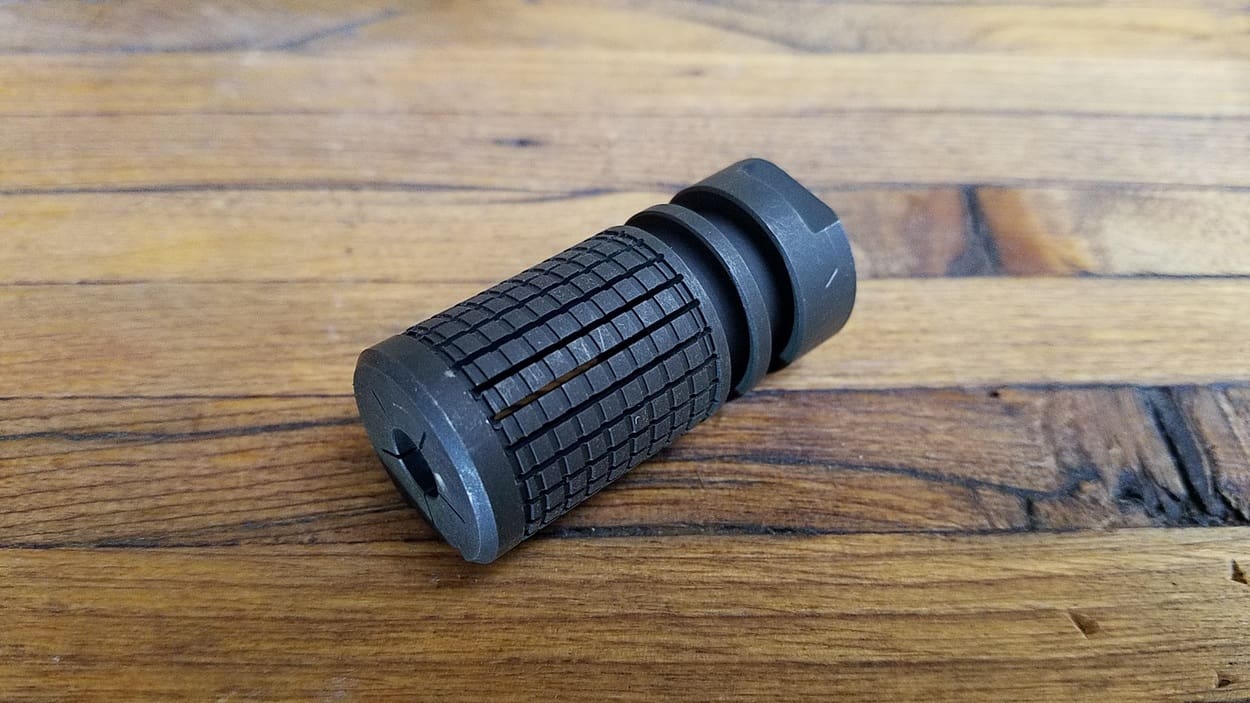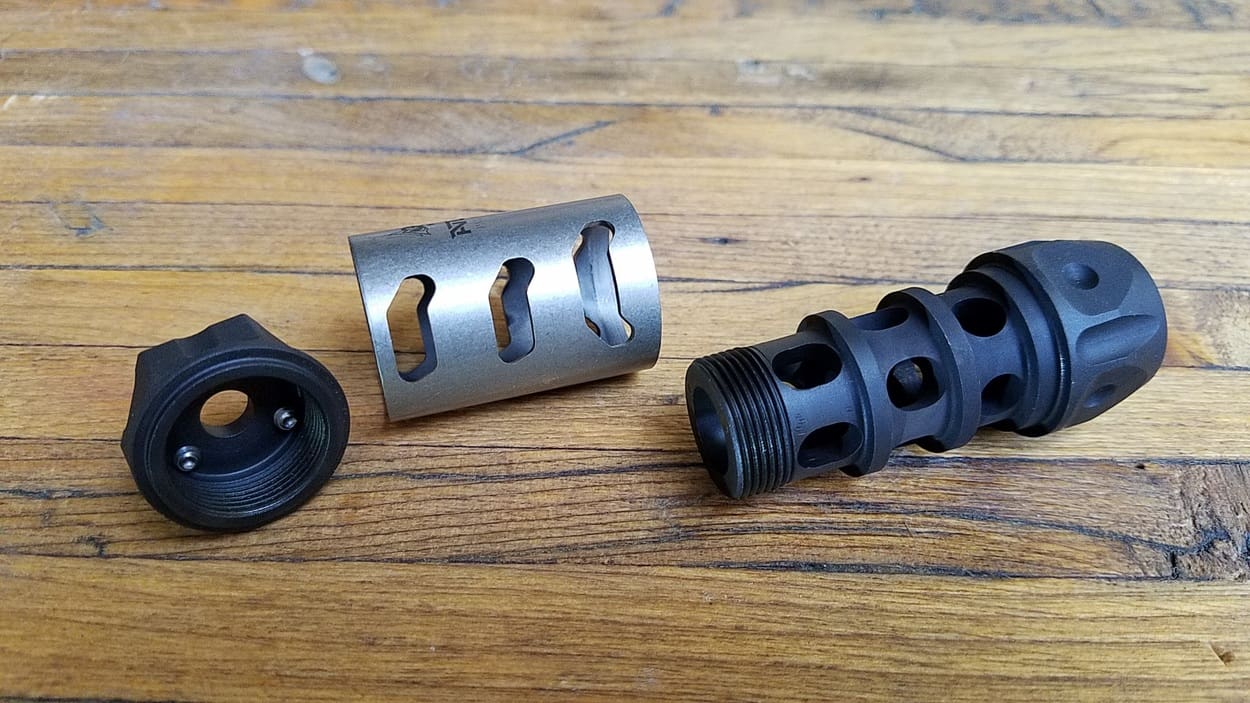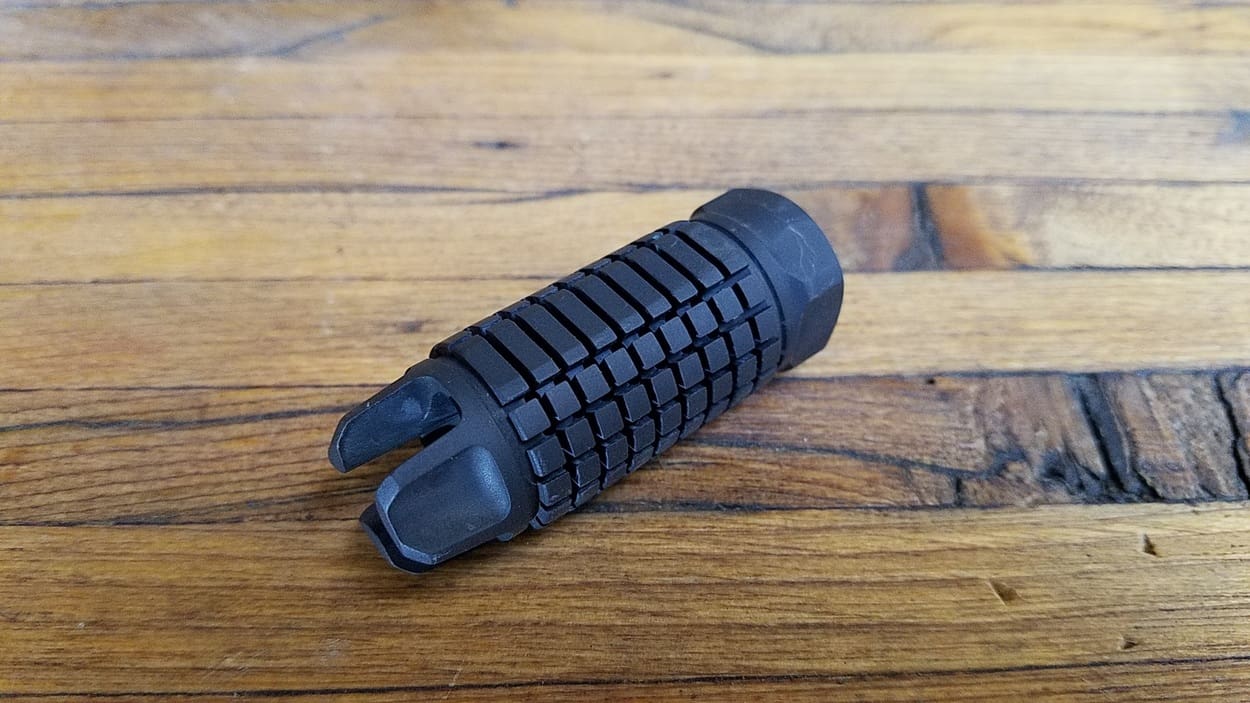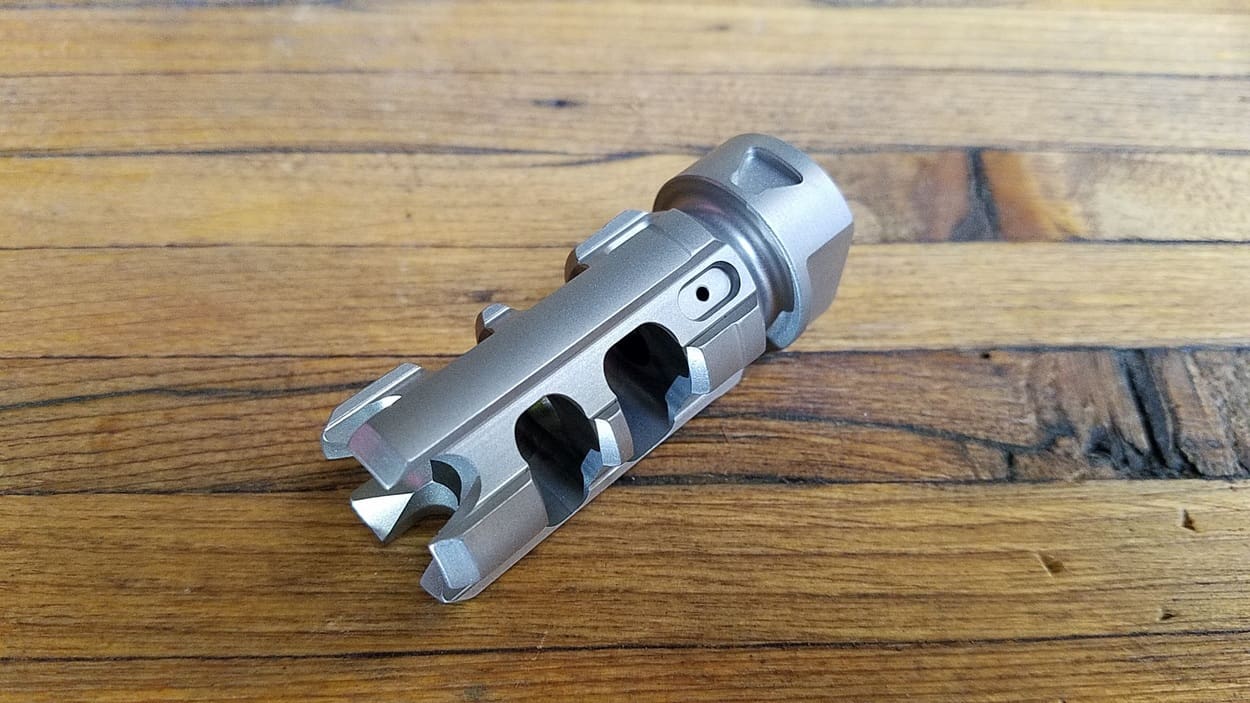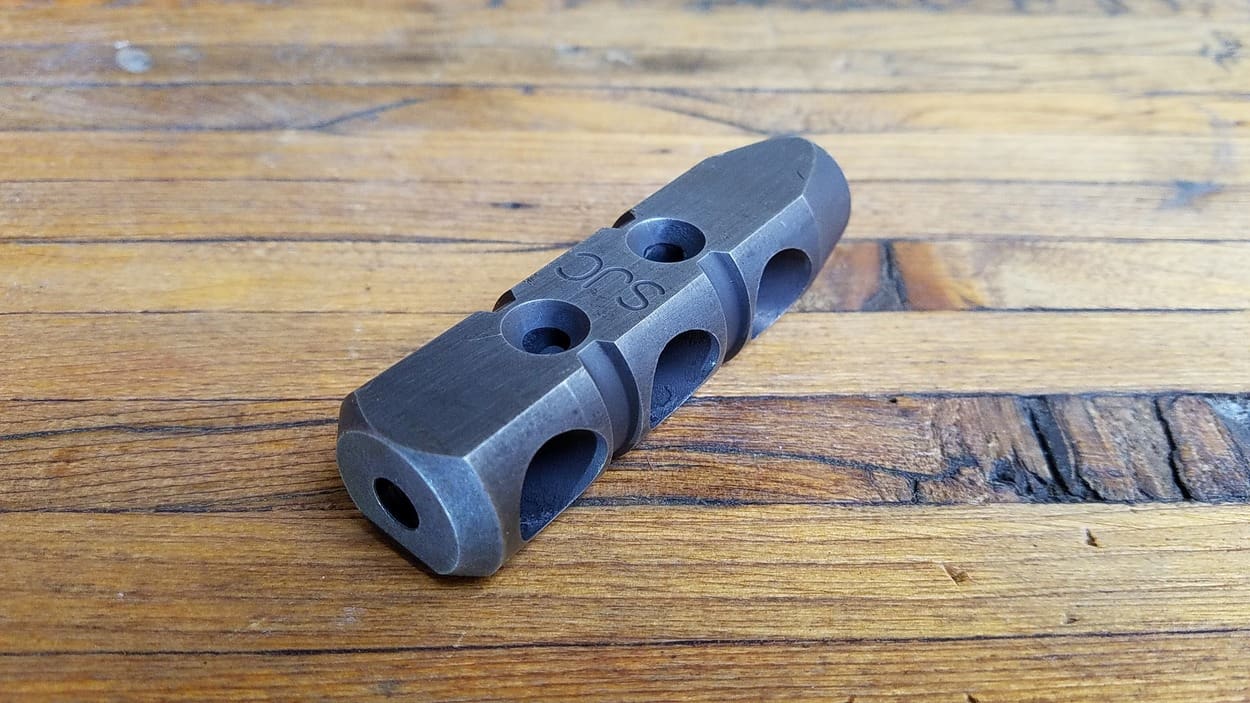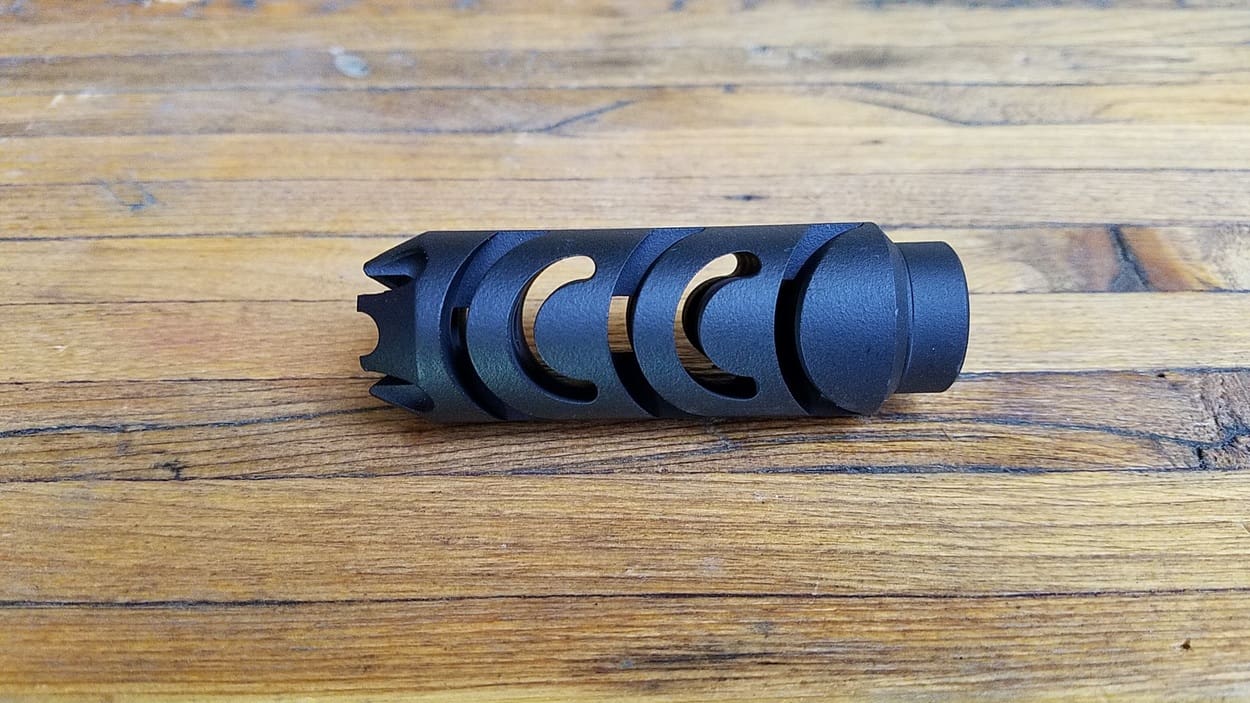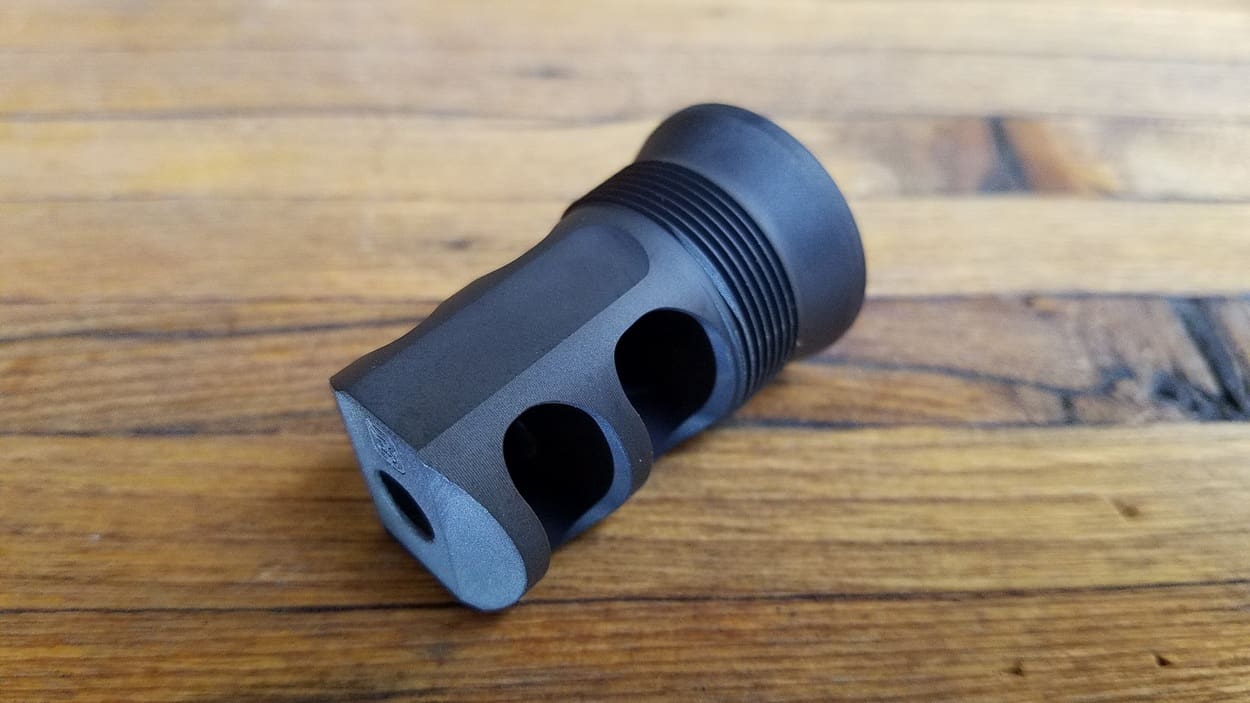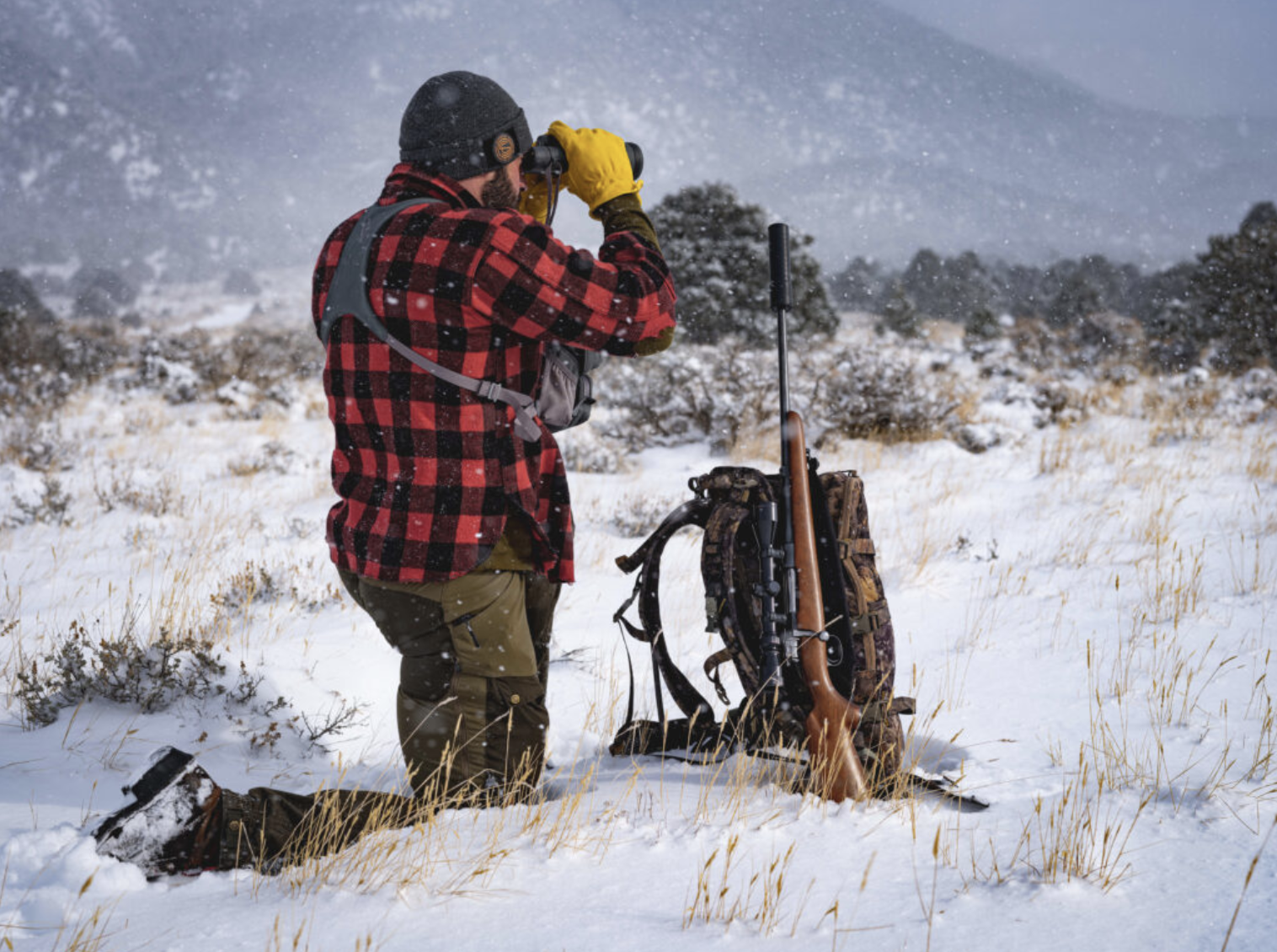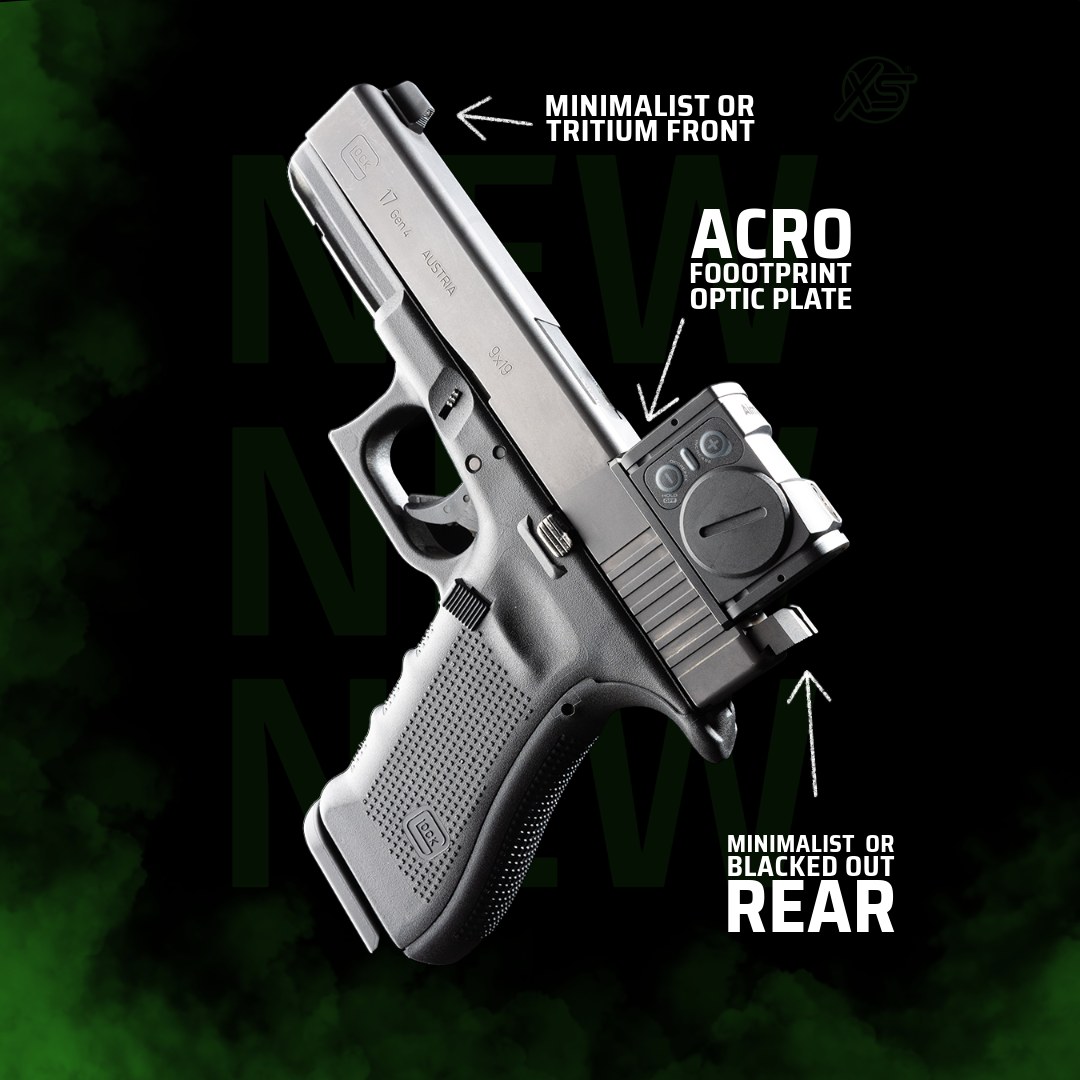Welcome to the third installment of our 5.56 muzzle brake testing series. This time around we’ve put 42 new muzzle devices to the test, measuring the recoil reduction performance of each.
Recoil Testing
The procedure for this test was the same as the previous brake tests. You can find the first one here, the second one there, and a .30 caliber version here. For the Operators out there, we got a sweet Lux meter and tested the muzzle signature reduction effectiveness of various flash hiders, brakes, and comps. Flash hiding test #1 is here, and #2 here. You may also be interested in the AR-15 Drop-In Trigger Roundup here.
These tests are expensive, but I’d love to do more. I’ve purchased air pressure sensors designed to log blast waves so we can compare the amount of concussion each muzzle device generates, and these will be used in test four. But I have a lot of brakes to round up for that and the funding is low. I also want to do another AR-15 trigger roundup (component triggers this time) and a couple of flashlight roundups (tactical and gun-mounted). Please consider supporting this sort of testing via my Patreon page. As a Patron you can also get free stuff, join live streams, gain early access, and more.
https://www.youtube.com/watch?v=4sBjQjC89uA
As the protocol remained the same as before, we’ll keep the description of it quick. For more info, refer to the video above and/or the previous 5.56 brake tests.
- My AR-15 was strapped to the test rig, which was free to slide on a plastic table. I measured how far the rig slid back for each shot. This is one method of quantifying rearwards recoil energy. Bare muzzle is the basis for comparison against which all of the muzzle devices are measured.
- Only a single round of Federal American Eagle XM193 was loaded for each shot (one in the chamber, zero in the mag).
- The rifle’s Adams Arms XLP gas piston system was turned off. This means the action did not cycle — the bolt remained locked in battery — and each round was manually ejected before loading the next.
- Each muzzle device was timed properly, and tested twice.
- Recoil distance was measured in 1/16″ increments. All of the data here has been converted from that to decimals.
As simple and as “redneck” as this test looks — and is, sure — the average difference between the shortest slide and the farthest slide across all 44, 2-shot tests was 0.1477″. It’s highly consistent and repeatable.
Without further ado, our recoil reduction winner is…drum roll please…
That’s right. A new champion has been crowned! The Precision Armament M4-72 was king of the recoil reduction hill against 138 other 5.56 competitors and 23, .30 cal competitors, but it just got Joffrey’d by the SJC Titan. It’s no fluke, either. After the initial round of testing I took another trip to the woods and did back-to-back testing with three types of ammo and different recoil sled weights, and the Titan always beat out the M4-72 (video of that starts here).
In the initial testing, the SJC Titan reduced recoil by 78.18% as compared to the bare muzzle. The M4-72’s performance was consistent with the previous shootouts, reducing recoil by 74.03%.
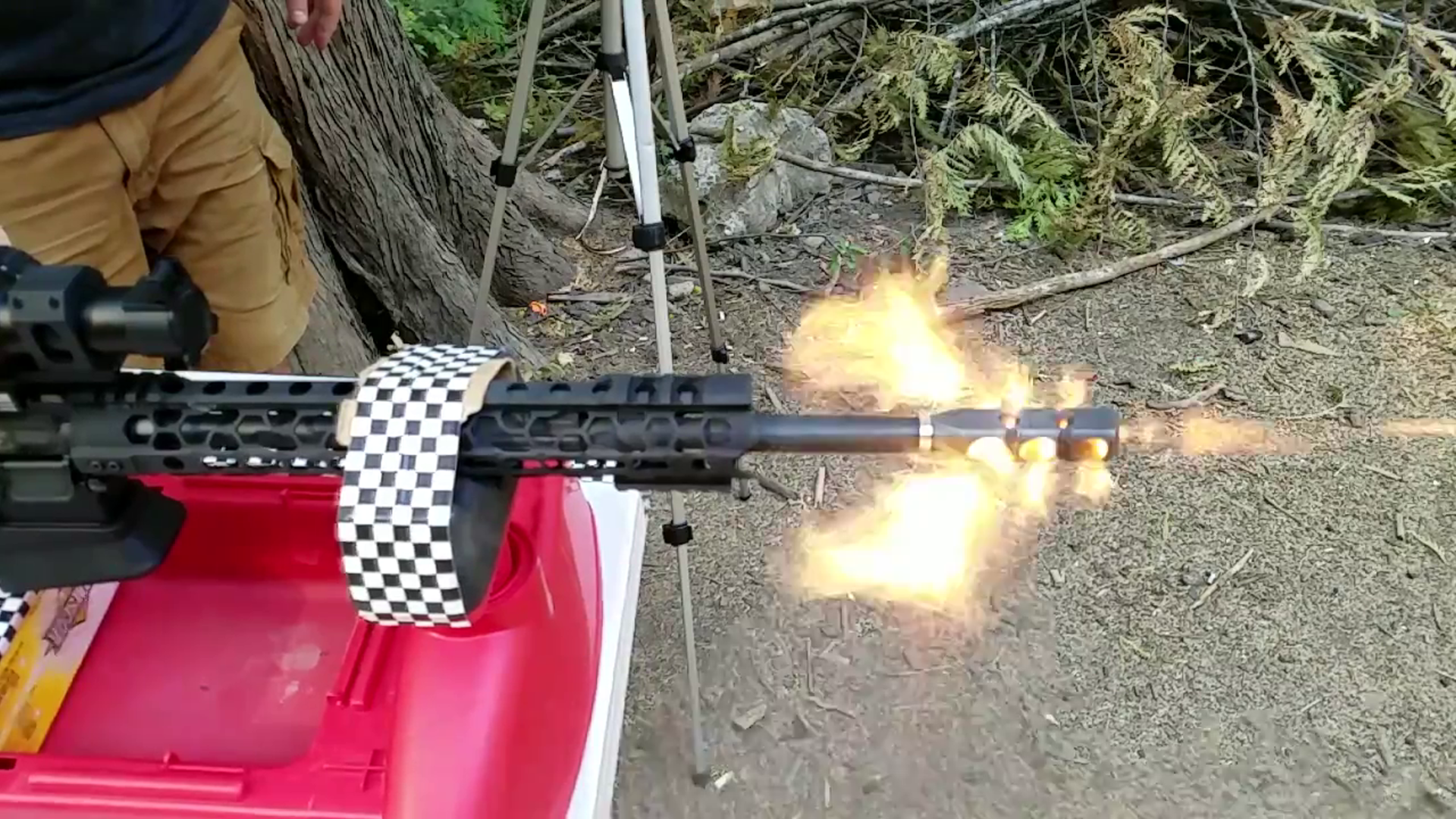
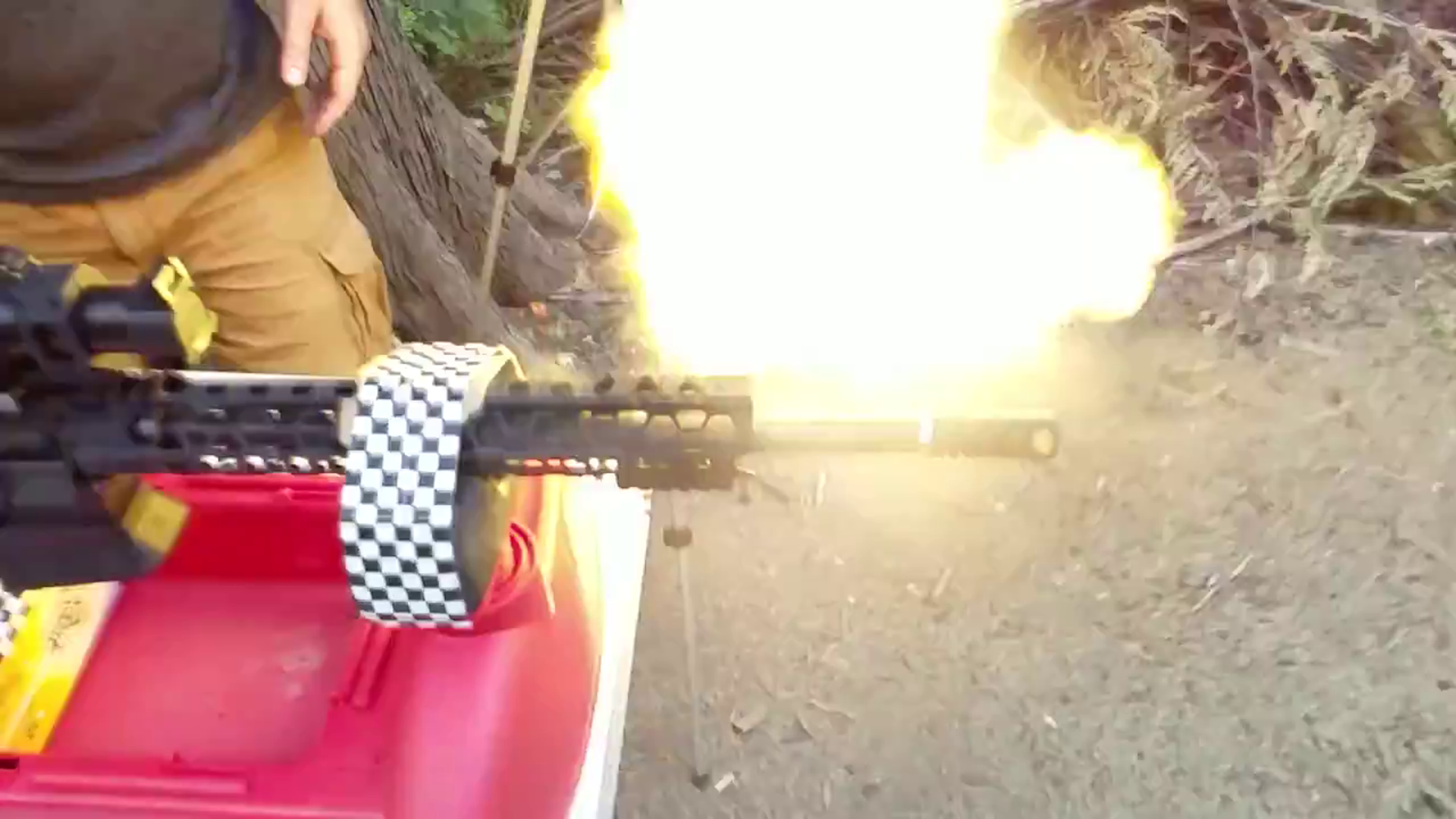
The Titan is larger and heavier than the M4-72, but breathes less fire. At least on the first shot in a string, as both of them get significantly less fiery — becoming basically equivalent — on subsequent shots. I believe the blast/wind from both of these brakes is approximately the same, but the Titan may have a little more concussion that your neighbors at the range will feel. You’ll find a split-screen, slow-mo comparison of each brake during rapid, offhand firing in the video here.
Note: there is no comparison whatsoever between the inch measurements in this test and those in the previous 5.56 tests (or the .30 cal test). The important stat is the recoil reduction as a percentage, which has proven pleasingly consistent.
Recoil test results for all of the entrants can be seen in the graphs and tables below. Click on any of the images in this article to see them full-size. Additionally, all of the raw data can be downloaded in an Excel doc by clicking here.
Muzzle Brakes / Compensators
Listed alphabetically. All stated weights and dimensions are as measured by me. I noted obvious errors on many manufacturers’ sites so chose not to use any of their info across the board.
2111 Arms 5.56/.223 Compensator:
I wasn’t familiar with 2111 Arms prior to coming across this comp, and I’m glad that I did. It’s a very compact, extremely lightweight compensator that truly surprised me with its recoil reduction performance. Material choice and machining are top quality. I’m not a huge black oxide fan, but 2111 Arms has done it here as nicely as it can be done. Concussion was minimal, and based on the slow-mo footage it compensates for muzzle rise fairly aggressively.
Click here to jump to its point in the video.
Material: 17-4PH stainless steel
Finish: black oxide
Length: 1.752″
Diameter (at largest point): 0.815″
Weight: 1.58 oz
MSRP: $95
Apex Tactical Enhanced Stabilization Attachment:
“Enhanced Stabilization Attachment” is a bit marketing-lingo-heavy for my tastes, but this muzzle brake has a good reputation for performance. In this test against tough competitors it ended up middle-of-the-road, but over 60% recoil reduction is nothing to sneeze at. A small gas vent hole above the first port (I managed to photograph it upside-down) provides a hint of muzzle rise compensation, which I think is just the right amount. Machining is clean, if simple, with no visible tool marks. Nitride finish is nicely done and has held up well on the high-mileage loaner unit I borrowed for this test.
Click here to jump to its point in the video.
Material: steel
Finish: Salt Bath Nitride (QPQ)
Length: 2.595″
Diameter (at largest point): 0.747″
Weight: 2.25 oz
MSRP: $59.95
Armageddon Tactical CompTek Type I Compensator/Brake:
Truly great machining and a flawless finish left me shocked when the CompTek refused to thread onto my rifle. In the 160+ muzzle devices I’ve tested, this was the first one that had to receive a DQ — I simply couldn’t install it. I’m fully willing to believe that this was a complete and total fluke, and Armageddon Tactical immediately offered a replacement, no questions asked, while also stating that they’ll be upping their inspection protocol to ensure this can’t happen in the future.
I didn’t take the replacement, though, as running a 1/2-28 thread tap through it — Melonite is really hard, by the way — resolved the problem completely. While it had to be DQ’d for the primary testing with the rest of these brakes, I did bring it out the following weekend when doing further testing between the SJC Titan and the Precision Armament M4-72. In that testing, it reduced recoil by 60.73% compared to a bare muzzle.
Click here to jump to its point in the video.
Material: 4140 steel
Finish: Melonite QPQ
Length: 2.752″
Diameter (at largest point): 0.951″
Weight: 4.868 oz
MSRP: $99
Black Dawn Muzzle Brake:
The Black Dawn Muzzle Brake’s baffles are unique in both functional and aesthetic design, with no top or bottom to them outside of the internal bore area (and no baffle wall inside the bore area), which also leaves unusually small, rectangular ports. I wasn’t expecting a lot of recoil-reducing performance, but cutting it by over 55% ain’t too shabby.
I dig subtle machine marks that show a piece like this has been turned down from stock on a lathe, and the Black Dawn wears it proudly. The nitride finish is very nice. Although I’d really appreciate 19mm wrench flats for easy installation, I understand that a narrow, 3/8″ wrench can be used on the flats between the baffles and, once installed, the smooth exterior can make for a clean look on a bull barrel of the right diameter.
Click here to jump to its point in the video.
Material: steel
Finish: nitride
Length: 2.803″
Diameter (at largest point): 0.874″
Weight: 4.48 oz
MSRP: $69
Cobalt Kinetics EVOLVE Pro Comp:
Cobalt Kinetics includes this brake on their EVOLVE Rifle in a handful of different finishes. Although it isn’t currently available for purchase separately, I was able to get my hands on one and figured we may as well include it in this test, especially considering the unique design. It’s certainly an extremely effective brake, cutting recoil by a hair over 70% without as much concussion as many brakes create, while maintaining a dead-steady muzzle.
The Cerakote job on my sample was done evenly and thoroughly, but the machining leaves something to be desired. Actually, most of it is crisp and clean, but on the flat, recessed area on both top and bottom and the wrench flats at rear, there are obvious tool marks that are deep enough to be felt with a fingernail. This brake should have been tumbled and/or media blasted after it was machined.
Click here to jump to its point in the video.
Material: steel
Finish: Cerakote (or similar)
Length: 3.372″
Diameter (at largest point): 0.933″
Weight: 4.445 oz
MSRP: not sold separately
CORE15 Rifle Systems .223/5.56 Muzzle Brake:
My CORE15 brake loaner is well-used, but the nitride finish still looks great. It’s an effective dual chamber brake with top vents to combat muzzle rise, muzzle prongs for flash reduction, and no flaws or tool marks that I can see.
Click here to jump to its point in the video.
Material: steel
Finish: black nitride
Length: 2.406″
Diameter (at largest point): 0.829″
Weight: 2.515 oz
MSRP: $59.99
Dead Air Armament Keymount Muzzle Brake:
Like most muzzle devices that act as QD mounts for a specific company’s suppressors, I think it would be a bit of an odd choice should one not own a matching suppressor. That said, Dead Air’s pricing is far lower than the typical QD-mount brake, and it’s a good looking, flawlessly machined and finished piece.
Click here to jump to its point in the video.
Material: steel (“high strength corrosion resistant alloy”)
Finish: black nitride
Length: 2.604″
Diameter (at largest point): 1.081″
Weight: 4.092 oz
MSRP: $89
Dead Air Armament Sandman Ti (.30 cal vs. .223 cal end caps):
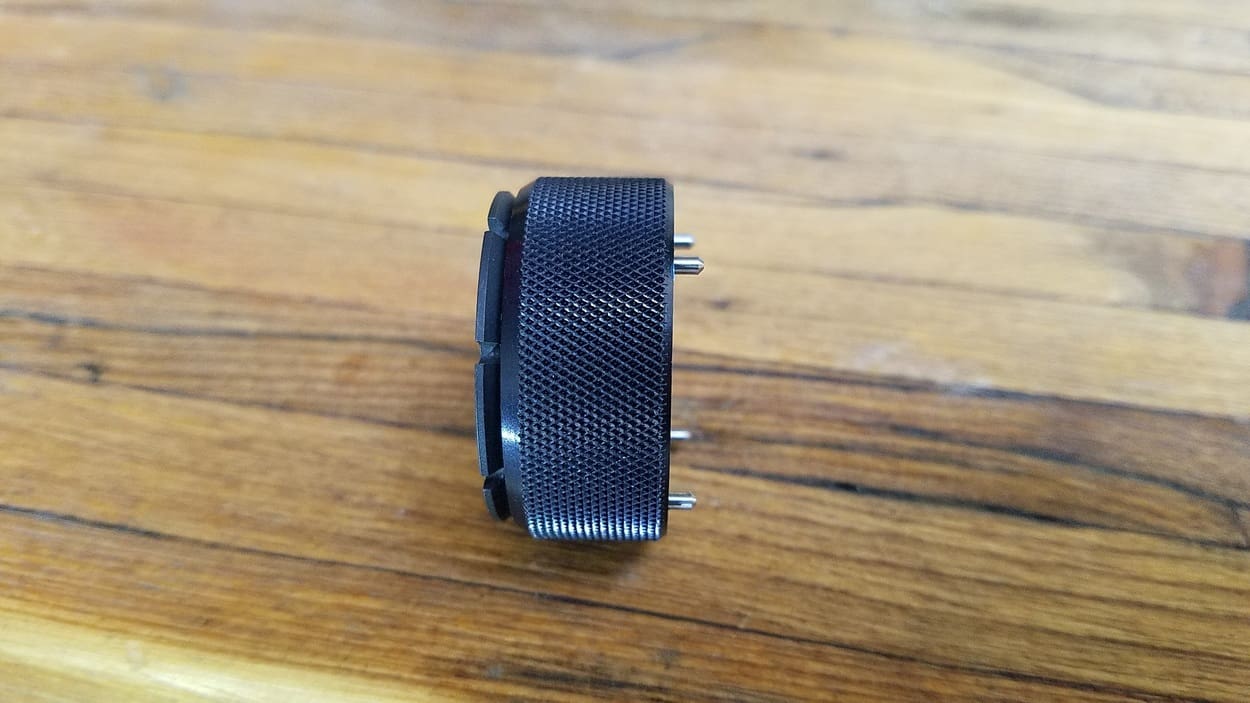
It’s well-established that suppressors do reduce recoil, although to varying degrees (like brakes and comps) based on design, caliber, and more. There has been a lot of back-and-forth in the industry about swappable suppressor end caps, though, with some stating that they’re nothing but a marketing ploy to sell accessories while some insist that they’re truly effective at reducing volume levels when shooting smaller diameter calibers through an oversized bore. Although I don’t yet have access to professional dB metering equipment to test volume level claims, I figured the same gas-trapping principals were likely to lead to a change in recoil reduction.
And, indeed, this is what we found. When shooting 5.56 through the .30 caliber end cap, the Sandman Ti reduced rearwards recoil by 46.69%. After switching to the .223 caliber end cap, recoil reduction jumped to 49.45%. Result! In my subjective opinion doing a little shooting out in the woods, I did also find it slightly quieter with the correctly-bored end cap. Not much, but enough to notice and to be relatively confident of it.
Machining and finish, like on the brake, is as good as it gets. I like this suppressor a lot. For the record, I used a Precision Armament thread adapter to thread the 5/8-24 suppressor onto my 1/2-28 rifle.
Click here to jump to its point in the video.
Material: Titanium tube, Stellite baffle core
Finish: Cerakote
Length: 8.2″
Diameter (at largest point): 1.5″
Weight: 16.8 oz
MSRP: $849
Diamondhead T-Brake Muzzle Compensator:
Diamondhead’s T-Brake was a hot request in the comments of muzzle brake test #1 and #2, both here and on YouTube. Clearly, a lot of people find the triangular shape compelling and wanted to know how the recoil reduction stacks up. In this tough competition it didn’t come within sight of the podium, but cutting recoil by more than half (55.52%) is still admirable.
Only at close-up inspection do minor flaws in machining and finish become apparent. Light tool marks on the circumference, a couple nicks on the 90° edges, and one or two really small points where finish is missing. Overall though it’s very good, and were it not for the close scrutiny of this test and the tough competition, it probably wouldn’t be noticed.
Click here to jump to its point in the video.
Material: hardened steel
Finish: black
Length: 2.805″
Diameter (at largest point): 1.014″
Weight: 4.057 oz
MSRP: $129
Dynamic Resistance Muzzle Break:
This little guy, regardless of whether it’s a “brake” or a “break,” punches well above its weight class. The packaging states a 62% recoil reduction vs. an A2 birdcage (which we have shown to reduce recoil by a few percent compared to a bare muzzle), and I found a 68.5% reduction vs. a bare muzzle. From a compact, 2-port brake, this is really impressive. Personally, I’d be an even bigger fan if the top ports were smaller, as I think they provide too much downwards force, but this is completely subjective and affects every shooter differently.
Machining and finish are perfect.
Click here to jump to its point in the video.
Material: 4140 steel or 17-4 stainless steel
Finish: Mil-spec Parkerize, or raw
Length: 1.752″
Diameter (at largest point): 0.876″
Weight: 2.484 oz
MSRP: $75
Fortis Muzzle Brake 5.56 Nitride:
Fortis makes a lot of cool-looking, futuristic, angular metal products for MSRs, and this new muzzle brake is certainly no exception. Machining and finish are excellent. Quality is obviously quite high and it does look pretty badass. Recoil reduction performance is good, but nothing to write home about compared to other brakes of its size.
Click here to jump to its point in the video.
Material: 4140 steel
Finish: black nitride
Length: 2.286″
Diameter (at largest point): 0.95″
Weight: 2.796 oz
MSRP: $89.95
Griffin Armament M4SD Hammer Comp:
Griffin’s M4SD line of suppressors and muzzle devices uses the same QD mounting grooves as the A2 birdcage, meaning their suppressors work on an A2 and their muzzle devices work with most other brands of A2-compatible suppressors. This is the Hammer Comp, a combo compensator / brake / flash suppressor. We found in Flash Hiding Test #2 that it’s about 37% brighter than an A2, which is a significant flash reduction vs. a bare muzzle, and in this test we see that it cuts recoil almost in half, putting the A2 to shame. Quality is excellent in every way. It’s a very clean piece.
Click here to jump to its point in the video.
Material: 17-4PH stainless steel
Finish: black oxide
Length: 1.751″
Diameter (at largest point): 0.866″
Weight: 2.271 oz
MSRP: $94.95
Griffin Armament M4SD Flash Comp:
Much to my surprise, Griffin’s M4SD Flash Comp beat the Hammer Comp on recoil reduction by 5%. It’s longer, so it may not work with some other brands of suppressors made to mount on an A2. Considering the low concussion, decent recoil reduction, and quality machining and finish, it’s a good choice with or without a suppressor attached.
Click here to jump to its point in the video.
Material: 17-4PH stainless steel
Finish: black oxide
Length: 2.26″
Diameter (at largest point): 0.866″
Weight: 2.89 oz
MSRP: $99.95
Kahntrol Solutions 3-Gun Brake:
Kahntrol Solutions’ hexagonal brakes have a unique and fun, somewhat industrial look to them. With no shortage of blast and concussion it’s sure to wake the neighbors, but you’ll be happy in the knowledge that you just sent 62% of your rifle’s recoil energy their way instead of into your shoulder. Machining is good but not perfect, although the tough, industrial look is probably complemented by a tool pass line here and there anyway — it looks like it was made to do real work. The black oxide finish was done very well.
Click here to jump to its point in the video.
Material: 4140 steel
Finish: black oxide
Length: 2.601″
Diameter (at largest point): 0.989″
Weight: 3.461 oz
MSRP: $94.95
Knight’s Armament MAMS:
The Multi-Axis Muzzle Stability (MAMS) brake from Knight’s Armament may cost an arm and a leg, but it’s also extremely expensive. It acts as a QD mount for KAC’s 5.56 suppressor line, and is a combination brake / comp / and flash hider. While it wasn’t particularly impressive in the flash hider testing, it did perform better in recoil reduction than I would have guessed based on the external design, cutting it down by almost 53%. Of course, with the end cap welded onto it, there could be more going on inside than meets the eye.
My loaner sample was well used and abused, but it’s clear that it was machined with great precision and deburred and smoothed out afterwards. No idea what the finish is or what it looked like when new, but most of it’s still hanging in there despite the high mileage on this muzzle device.
Click here to jump to its point in the video.
Material: steel
Finish: black
Length: 2.2″
Diameter (at largest point): 0.864″
Weight: 2.35 oz
MSRP: $299.95
Knight’s Armament Triple Tap Flash Suppressor/Compensator:
Wire EDM-machined from Inconel, the ~$450 KAC 3T puts the MAMS’ price tag to shame. It’s no longer available (sorry, I know I just shattered your plans to impulse buy one), but it was loaned to me with the MAMS so I figured I’d test it. If nothing else, it’s a really cool exercise in what can be done with extreme-precision manufacturing…although there still are a few little melty mistakes from the wire either at the start or end of its pass for most of the longitudinal grooves. Anyway, it placed third from last in this test, behind two flash hiders.
Click here to jump to its point in the video.
Material: Inconel
Finish: bare
Length: 1.88″
Diameter (at largest point): 0.865″
Weight: 2.66 oz
MSRP: $450 (not in production)
Lilja Heartbraker Muzzle Break:
Lilja makes some of the most accurate barrels in the business, so turning out a perfectly-machined muzzle brake ain’t no thang. This heart-shaped port/baffle design seems to be highly effective (see the Thunder Tech brakes in Test #2, too), netting a 65% recoil reduction out of a barrel-diameter brake. This is another brake with no wrench flats, but Lilja sells a tool for torquing it down via one of the ports. I may or may not have used a screwdriver.
Click here to jump to its point in the video.
Material: stainless steel
Finish: raw
Length: 2.373″
Diameter (at largest point): 0.74″
Weight: 2.337 oz
MSRP: $125
Nord Arms Open Brake:
Nord Arms is a competition-focused rifle parts company out of Estonia. Their parts aren’t currently for sale in the U.S. that I know of, but they’re expected to be available through Brownell’s and other retailers in the near future. This is their Open brake, designed for competition classes that don’t limit brake size. Considering the huge, rearwards-angled baffles I figured this guy would be in the running for unseating the reigning champion but, alas, it was not to be. The Open came in 5th by reducing recoil by 72.38%, but realistically it tied for 3rd as the difference between the 3rd, 4th, and 5th place brakes was so incredibly small.
Machining and finish are average.
Click here to jump to its point in the video.
Material: 416 stainless steel (also available in titanium)
Finish: black matte QPQ nitriding (dark grey matte thick carburizing in titanium)
Length: 2.246″
Diameter (at largest point): 1.366″
Weight: 4.586 oz (2.68 oz in titanium)
MSRP: $67
Nord Arms Standard Brake:
For an aggressive, but not quite howitzer-like look, and for staying within size restrictions for some competition classes (although I believe in the U.S. it’s 1.0″ that’s used as a limit in some classes, meaning this one would technically be too big at 1.02″), Nord Arms makes their Standard brake. It’s more compact, but it’s still a recoil cutting beast with an over 68% reduction.
Again, I’d say the machining and finish on the steel one is about average, but the time spent sandblasting the titanium one has removed tool marks and teeny burrs and has effectively made it flawless.
Click here to jump to its point in the video.
Material: 416 stainless steel (also available in titanium)
Finish: black matte QPQ nitriding (dark grey matte thick carburizing in titanium)
Length: 2.44″
Diameter (at largest point): 1.02″
Weight: 3.451 oz (2.01 oz in titanium)
MSRP: $56
ODIN Works ATLAS 5 Comp:
This very unique compensator is comprised of three pieces: a baffle core, a titanium sleeve, and an end cap. First, the core gets installed on the rifle. Timing it is not necessary, as that’s the job of the Ti sleeve, which goes on next. Rotating the sleeve exposes different baffle core ports and changes the direction of the expanding gasses, including through the small muzzle rise control vent on top (can be enlarged with a drill, if desired). Once the sleeve is timed to one’s preference, the end cap is torqued down and three set screws lock it and the sleeve solidly in place.
Machining and finish are awesome, and the look sets it apart. A 64% recoil reduction is surprising for a comp. And how could I go without mentioning the cool packaging? Although I’m not actually sure if they’re still doing this, my ATLAS 5 shipped in a sealable glass canister with acid-etched ODIN Works ATLAS 5 logo.
Click here to jump to its point in the video.
Material: 416R stainless steel core and cap, titanium sleeve
Finish: black nitride on steel, sleeve left raw
Length: 2.56″
Diameter (at largest point): 1.0″
Weight: 4.198 oz
MSRP: $99
Phase 5 FATman Hex Brake:
I think it’s fair to say that Phase 5 was going for some loud aesthetics when they came up with the FATman brake. It’s big, angular, and has a lot of visual interest, looking particularly cool with its base tucked underneath an extended handguard. Phase 5 has done a truly great job machining all of the angles, chamfers, grooves, slots, and threads here, and the parkerizing is as nice as it can be.
Click here to jump to its point in the video.
Material: steel
Finish: Mil-spec black parkerized
Length: 3.007″
Diameter (at largest point): 1.264″
Weight: 6.138 oz
MSRP: $115
Precision Armament AFAB-556 Hybrid Muzzle Brake:
The AFAB is my go-to, all-around muzzle device, although in this crowd of highly effective brakes and comps its 50.55% recoil reduction seems less impressive than it really is. It continues to end up back on my rifles due to its excellent combination of muzzle stability, low blast, low concussion, low flash, and meaningful recoil reduction. And I happen to really like how it looks (that’s the sole reason I’m running it instead of the EFAB, which slightly outperforms it otherwise).
As with everything I’ve seen from Precision Armament, machining and finish are industry-leading.
Click here to jump to its point in the video.
Material: HTSR 416 stainless steel
Finish: Ionbond CrCN, matte black
Length: 2.23″
Diameter (at largest point): 0.866″
Weight: 3 oz
MSRP: $109.95
Precision Armament M4-72 Severe-Duty Compensator:
After two 5.56 tests and one .308 test, I’m sure the M4-72 is pretty bummed out to have been dethroned as reigning recoil reduction champion. It’s still good for a 74% reduction in recoil, which is absolutely amazing, but the SJC Titan did a whopping 78%. The M4-72 is smaller and lighter than the Titan, but it also spits more fire. I believe the blast/wind from both of these brakes is approximately equivalent, but the Titan may have a little more concussion that your neighbors at the range will feel.
As with the AFAB, machining and finish are as good as it gets.
Click here to jump to its point in the video, and here for the additional M4-72 vs. Titan back-to-back testing.
Material: HTSR 416 stainless steel
Finish: Ionbond CrCN matte black or bead blast stainless
Length: 2.25″
Diameter (at largest point): 0.875″
Weight: 2.55 oz
MSRP: $89.99
Rainier Arms Compensator (RAC):
RAC ’em up! Great performance, great machining, great finish, all at a great price. Or at least a very competitive price. Hard to argue with that if the RAC’s looks are to your liking.
Click here to jump to its point in the video.
Material: stainless steel
Finish: black or bead blast stainless
Length: 2.314″
Diameter (at largest point): 0.891″
Weight: 2.665 oz
MSRP: $69
Rainier Arms Xtreme Tactical Compensator (XTC) 2.0:
Rainier Arms’ XTC 2.0 looks like it’s attacking me from the future. Actually, it could be a lot of fun to build a mecha-themed rifle to match (yes, that’s a challenge). The XTC cut recoil by over 63% and, like the RAC, the machining is flawless. While the RAC was nitrided, this XTC is bead blast bare stainless, although both brakes are available in either finish.
Click here to jump to its point in the video.
Material: stainless steel
Finish: bead blast stainless, or black nitride
Length: 2.355″
Diameter (at largest point): 0.95″
Weight: 3.299 oz
MSRP: $79.95
Rifenbark Armory S.O.M. (Sound of Madness) Muzzle Brake:
This was another brake I wished had wrench flats while resorting to the ol’ screwdriver-through-the-port trick, then I felt stupid when I later found the tool it ships with sitting in my bag. If you’ve always wanted a V12 on your rifle, look no further. Seriously though, the Rifenbark primarily focuses on combating muzzle rise without sending a blast of carbon and fire through your sight picture. A long, single port is added to reduce recoil (by almost 46%) without excessive blast or concussion. Machining and finish are above average (and my loaner is used).
Click here to jump to its point in the video.
Material: steel
Finish: black (it looks parkerized)
Length: 2.106″
Diameter (at largest point): 0.866″
Weight: 2.637 oz
MSRP: $89.99
Lund/SJC .223 Titan Compensator:
Here it is, the new king of the recoil reduction hill! First, I feel compelled to apologize for not including the SJC Titan in my first couple of muzzle brake tests. Despite its obvious popularity on the competition shooting circuit, I couldn’t find one to borrow, couldn’t get through to the manufacturer, and didn’t put it high enough on my list to spend $90 from the limited budget to purchase one. Some of that was actually because I didn’t believe it would net a noteworthy performance. I felt that way because those three, round ports always appeared in photos as though they were simply drilled through the brake perpendicular to the bore. It appeared simplistic, frankly, and I was confident of a middle-of-the-road result.
 Turned out I was completely wrong, not only of the result but of the SJC’s build. As you can clearly see in the photo above, the ports are angled rearwards; a common theme among all of the top-performing brakes. Round ports at a ~45° angle to the round bore makes for an interesting internal shape where port and bore meet to create baffle, and it certainly seems to work. The SJC Titan captures and redirects more gas than the M4-72 does, yet it accomplishes this with less fire. Blast/wind seems about the same, although it may have just a hair more concussion if you’re off to the side.
Turned out I was completely wrong, not only of the result but of the SJC’s build. As you can clearly see in the photo above, the ports are angled rearwards; a common theme among all of the top-performing brakes. Round ports at a ~45° angle to the round bore makes for an interesting internal shape where port and bore meet to create baffle, and it certainly seems to work. The SJC Titan captures and redirects more gas than the M4-72 does, yet it accomplishes this with less fire. Blast/wind seems about the same, although it may have just a hair more concussion if you’re off to the side.
Machining is pretty dang clean, but as you can tell my loaner from Lisa Marie AKA “Lady 3 Gun” is very, very used.
Click here to jump to its point in the video, and here for the additional Titan vs. M4-72 back-to-back testing.
Material: steel (also available in stainless steel)
Finish: black (also available in matte stainless finish)
Length: 3.258″
Diameter (at largest point): 0.98″
Weight: 5.679 oz
MSRP: $90
SureFire WARCOMP 556:
The WARCOMP is primarily a flash hider — a pretty good one, at that — but it adds a blast baffle / expansion chamber with circular ports to provide muzzle rise compensation and recoil reduction. SureFire says it’s “the world’s most shootable flash hider,” which is obviously a hard claim to put to the test, but then again it reduced recoil by nearly 36% — the most of any “flash hider” I’ve tested for recoil, I do believe.
As with all of the brakes and flash hiders I’ve had from SureFire, machining and finish are totally flawless. The WARCOMP has no wrench flats, but ships with a custom tool that engages the prongs and allows the use of a socket wrench to torque it down.
Click here to jump to its point in the video.
Material: heat treated stainless steel bar stock
Finish: Ionbond DLC
Length: 2.736″
Diameter (at largest point): 1.0″
Weight: 3.845 oz
MSRP: $149
Tactical Advantage Armory 3P-23 Titanium 3%er Muzzle Brake:
Tactical Advantage Armory sent me a whole collection of brakes and comps, most of which are made from their metal of choice, Titanium. At least prior to testing them it was my opinion that they were made to look cool and really nothing else, but it turns out they all performed admirably. The 3%er here is a bit of an homage to the III% patriot/constitutionalist movement, with baffles cut in the pattern of III%. This guy reduced recoil by 58%.
Machining is excellent, except for the wavy side edges (I’m assuming they should be dead straight) of those front “wings” above and below the III ports. There are no wrench flats on this brake, so a screwdriver went through one of the circular % sign holes to good effect.
[EDIT: Tactical Advantage Armory informed me that I received units that are functionally identical (exact same port design) to their production units, but were either late-stage pre-production prototypes or “blem” versions made while they were refining the CNC machine code. Production versions should be without machining flaws.]
Click here to jump to its point in the video.
Material: Grade 5 titanium
Finish: bead blast titanium or many Cerakote color options
Length: 2.54″
Diameter (at largest point): 1.259″
Weight: 3.422 oz
MSRP: $249.99
Tactical Advantage Armory BC-23 Compensator:
My BC-23 sample is stainless steel, but on the TAA website it appears titanium is the only option [EDIT: TAA confirmed that they only make Ti brakes. This one was made while they were refining the CNC code]. Netting a 62.7% recoil reduction in a tiny, lightweight package means I’m definitely a fan.
Machining is super clean, and, although I like to complain about a lack of wrench flats, the round ports that go straight through the BC-23 lend it particularly well to torquing via screwdriver. The upside to that is a clean aesthetic as the diameter of the BC-23’s perfectly round base is going to line up nicely with most standard barrel profiles.
Click here to jump to its point in the video.
Material: Grade 5 titanium (although my sample is stainless steel)
Finish: bead blast titanium or many Cerakote color options (mine is machined stainless)
Length: 1.808″
Diameter (at largest point): 1.0″
Weight: 1.42 oz in titanium, 1.77 oz in stainless
MSRP: $135.99 in titanium (not available in stainless)
Tactical Advantage Armory CC-23 Titanium Muzzle Brake:
CC may stand for “C-Comp” or something, and I think it’s obvious from the side view why TAA may have called it that. This certainly isn’t a small brake, but it nails a 66% recoil reduction and, being titanium, prevents it from being the tank it would be in steel.
Machining and Cerakoting are both very clean. I suppose a strap wrench would be the way to install this guy as, again, there are no wrench flats but also really no other appropriate feature to exploit for torquing purposes (I may have shoved the shaft of a screwdriver in the muzzle teeth).
Click here to jump to its point in the video.
Material: Grade 5 titanium
Finish: bead blast or many Cerakote color options
Length: 2.977″
Diameter (at largest point): 1.009″
Weight: 3.284 oz
MSRP: $224.99
Tactical Advantage Armory NES-23 Titanium 3-Gun Compensator:
Despite its decent size, the titanium NES-23 weighs only 1.65 ounces, making it feel like it’s made of air. It’s pleasant to shoot, although it’s the same on all four sides so it could kick up dust pretty well from prone. It barely edged out the CC-23 with a 66.57% recoil reduction.
Really good machining but for small imperfections on the straight edges at top and bottom of the ports [EDIT: Again, TAA reminds me that my samples were not production-grade]. Wrench flats!
Click here to jump to its point in the video.
Material: Grade 5 titanium
Finish: bead blast or many Cerakote color options
Length: 2.51″
Diameter (at largest point): 1.0″
Weight: 1.652 oz
MSRP: $235.99
Tactical Advantage Armory NT-23 Titanium Muzzle Brake:
The NT-23 is more than 4 inches of fish scale-lookin’ shark teeth with ports everywhere. Venting gas into those rearwards-facing baffles once again seems to work very well, as the NT-23 was a top performer here turning in a 69% recoil reduction. I’m not sure what would be involved in permanently attaching a titanium brake to a steel barrel, but the length of this thing would likely bring a 12.5″ barrel up to the legal minimum for a rifle.
Machining is great everywhere except for obvious tool pass marks on the center-facing sides of the baffles. No wrench flats, despite a perfect place for them. [EDIT: TAA informed me that production versions of this brake do have wrench flats and don’t have tool marks]
Click here to jump to its point in the video.
Material: Grade 5 titanium
Finish: bead blast or many Cerakote color options
Length: 4.03″
Diameter (at largest point): 1.0″
Weight: 3.15 oz
MSRP: $249.99
Thunder Beast Arms Corporation 223CB Muzzle Brake:
Well if this isn’t the #1 surprise outperformer of the test, I don’t know what would be. The 223CB is incredibly compact, but its two, rearwards-angled baffles are obviously highly efficient at catching and redirecting gas and pressure. This bad boy landed in third place, providing a whopping 72.93% reduction in recoil. In addition to being a highly effective brake, it acts as a QD mount for Thunder Beast’s excellent, lightweight suppressors. I’d love to see them offer this brake in a simpler, lighter, less-expensive version sans the suppressor mounting elements, and I’m sure it would sell like crazy.
Machining and finish is as nice as it gets from any company. Absolutely top-notch. …although, now that I’m looking at the photograph again (the brake went to Tyler Kee for use with his TBAC cans), it appears as though one of the suppressor mounting threads is squished…
Click here to jump to its point in the video.
Material: steel
Finish: Ionbond DLC
Length: 1.71″
Diameter (at largest point): 1.065″
Weight: 2.51 oz
MSRP: $125
Troy Industries Proctor Muzzle Brake:
Frank Proctor runs the Way of the Gun firearms training school and has also created many Way of the Gun firearms products such as slings, sights, controls, and this muzzle device. It’s made by Troy Industries, and is meant to be a good all-around unit functioning as a brake and a comp while keeping flash to a minimum. Recoil reduction was truly excellent at 68.2%, making it more of a brake than I was anticipating (with the blast and concussion to match).
Machining and finish, as with most of the muzzle devices I’ve had from Troy, are average. I might whine if it were my receiver, but I think the level of attention and care is totally fine for a muzzle brake.
Click here to jump to its point in the video.
Material: heat treated ordnance steel
Finish: black
Length: 2.151″
Diameter (at largest point): 0.852″
Weight: 3.101 oz
MSRP: $74
Tufforce Muzzle Brake with 4-side Picatinny Rail:
You’re now reading about what is possibly the stupidest F’ing thing on the planet. Well, considering I paid $22.99 of my own money for it I suppose that could be up for debate. At any rate, this aluminum (no. Just no. Don’t make muzzle brakes for centerfire rifle calibers from aluminum!) brake is adorned with Picatinny rail. On all four sides. Wait, in front of the ports? Yes, that’s right. It’s also so, so wrong.
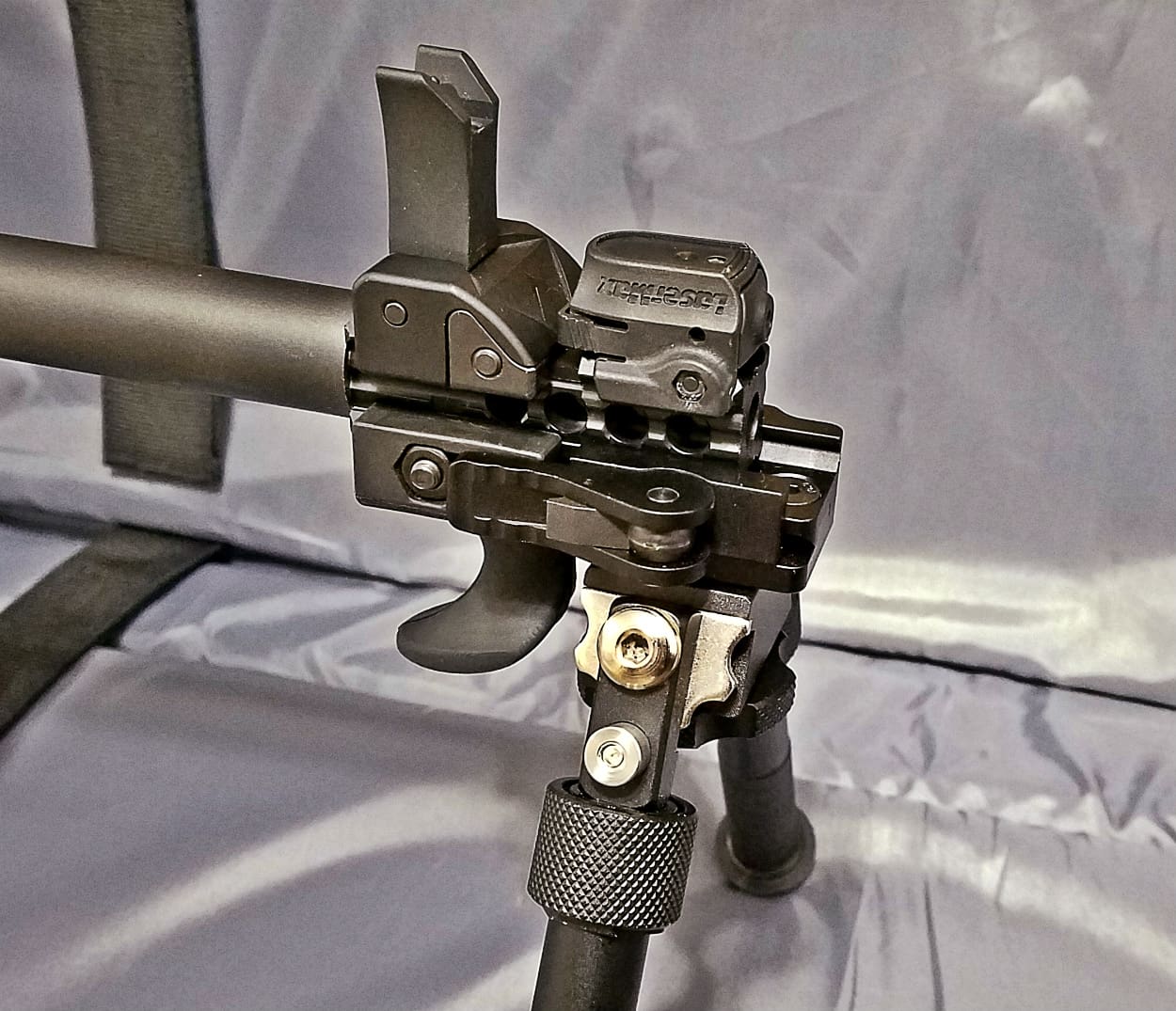
I think it’s obvious why mounting accessories to your muzzle brake isn’t a great idea. For multiple reasons. While I can’t really come up with anything that would make sense to mount to this thing, I’d just like to point out that the Tufforce website suggests that one of the best options is a front sight. Increase sight radius and such. Apparently they don’t realize that the height of this rail is way lower than AR rail height, and it would be basically impossible to jury rig a sight onto this thing at a usable height. Or maybe they do realize it, and the whole thing is just for trolling the market.
Except as a gag gift (I suggest including a TAC-SAC with it, plus a waiver of liability), please, please stay far away from this thing. It’s funny, but not functional.
Click here to jump to its point in the video.
Material: 6061-T6 aluminum
Finish: black hard anodized
Length: 2.562″
Diameter (at largest point): 1.042″
Weight: 1.118 oz
MSRP: $28.99
V Seven Weapons Systems FURION:
I pretty much love this titanium brake from V Seven. It combines perfect machining and finish with cool, modern aesthetics, unbelievably light weight, and solid performance (64.36% reduction).
Click here to jump to its point in the video.
Material: Grade 5 titanium
Finish: bead blast titanium or Ionbond black
Length: 2.304″
Diameter (at largest point): 0.952″
Weight: 1.67 oz
MSRP: $133
V Seven Weapon Systems V SEVEN Muzzle Brake:
Okay so this is a first for me — a muzzle brake with a full-on, large port running one direction followed by another clocked 90° off from it. It looks unique, but I’m not sure it has a real performance purpose other than kicking up dust if you’re shooting prone. Once again though, V Seven’s machining and finish is great.
Click here to jump to its point in the video.
Material: heat treated 303 stainless steel
Finish: bead blast stainless or black nitride
Length: 2.222″
Diameter (at largest point): 0.901″
Weight: 2.674 oz
MSRP: $79
Venom Defense & Design AR-10, 2-Port Compensator:
Venom Defense is a bit of an Instagram celebrity (page here), especially among the “machinist porn” crowd. Unfortunately, I’m a slacker and this test is massively delayed from when I planned on running it, so Venom Defense’s designs have evolved a bit since. Most notably, this design is no longer offered for 5.56 and is now most similar to their .30 caliber, 5/8-24 brake. As we saw in the .30 cal test, though, a good design is a good design, and relative performance carried over between calibers very closely.
One of Venom’s big claims to fame is manufacturing their brakes in various metal options. Seen here is stainless steel (the pink hue on the front, by the way, is a reflection of the light I was using; the brake is 100% stainless color), but titanium is an always-available option and other metals like copper, brass, and other alloys come in and out for limited times. There are typically many finish options to choose from, too.
Long story made long, it reduced recoil by almost 69% — but, holy crap, watching the slow-mo it pretty clearly kicks the muzzle down hard — and it looks pretty awesome. Leaving the un-touched-up, raw machined finish is a bit ballsy as it leaves every little nick and imperfection fully visible. There are some of those, but overall it’s a clean and consistent-looking piece.
Click here to jump to its point in the video.
Material: stainless steel (also available in titanium, and sometimes other metals)
Finish: machined stainless (as tested) or Cerakoted (in Ti, Cerakote or flame anodized)
Length: 2.506″
Diameter (at largest point): 1.2″
Weight: 4.691 oz (2.5 oz in titanium)
MSRP: $79 and up
Venom Defense & Design AR-15, 3-Port Compensator:
A copper alloy brake definitely looks pretty slick, and this one also happens to work. Reducing recoil by 72.65% was good enough for a fourth place finish (really, it was effectively in a tie for third). I just wish it didn’t get dirty so fast from shooting with it. With the top vents starting after the first port, it appears to have a more controlled amount of muzzle rise compensation than the other VD brake tested above.
Click here to jump to its point in the video.
Material: Copper alloy (as tested), also available in steel, titanium, and sometimes other metals
Finish: machined copper (as tested), also available Cerakoted, nitrided, and other finishes depending on metal
Length: 2.503″
Diameter (at largest point): 1.198″
Weight: 5.573 oz (as tested in copper), 0.95 oz in titanium, 1.7 oz in steel
MSRP: $69 and up
VooDoo Innovations Jet Comp 5.56:
The VooDoo Jet Comp is a simple, well-made, 3-port brake that performs extremely well. In every way it’s a solid muzzle brake / compensator choice, and at a lower price point I think it would be one of the more popular brakes on the market.
Click here to jump to its point in the video.
Material: steel
Finish: LifeCoat
Length: 2.313″
Diameter (at largest point): 0.94″
Weight: 3.551 oz
MSRP: $89.18
WeaponTech Punisher Compensator/Flash Hider:
The WeaponTech Punisher Comp/Flash Hider, sold via Primary Arms (and designed by the same guy who created the ACSS scope reticle, which I absolutely love), is a novel combination of brake, comp, and flash hider. Obviously recoil reduction is achieved with the rearwards-angled baffle of the single port, and flash reduction comes from the glass breaker-tipped prongs. Less obvious is the Punisher’s muzzle rise compensation, which comes from the top slot between prongs starting sooner (closer to the muzzle) than the others, meaning gas and pressure will begin venting out of it first and providing a muzzle rise-reducing downwards force. For more on the design features, see this video.
In Flash Hiding Test #2 we saw that the Punisher is brighter than an A2 birdcage, but stealthier than most any typical brake. In this test, we find that it reduces recoil by almost 50%. Although I had actually hoped for a bit more, this is certainly nothing to sneeze at. Machining and finish are awesome; no flaws.
Click here to jump to its point in the video.
Material: 4140 chrome moly steel
Finish: salt bath nitride
Length: 2.36″
Diameter (at largest point): 0.866″
Weight: 2.983 oz
MSRP: $69
White Sound Defense FOSSA-556:
Last but not least is the White Sound Defense FOSSA-556. I’ve been very excited to recoil test this “flash hiding compensator” since it nearly won Flash Hiding Test #2, despite not technically being just a flash hider. By timing the FOSSA with the widest of the three prongs/tines at bottom, the majority of gas volume and pressure is biased upwards, which provides a downwards push on the muzzle that is pronounced enough to be seen in the slow-mo footage.
In addition to that, the unique design is supposed to provide some recoil reduction via prongs that increase in width as they approach the muzzle. The theory here is that it creates somewhat of a baffle-like restriction at the front, forcing more gas and pressure out the sides, and therefore less out the muzzle, than would happen with straight prongs. This may appear awfully subtle, but a 21.55% recoil reduction really isn’t. I’m sure recoil could be reduced further by coming closer and closer to sealing the gaps between the prongs at the muzzle end and creating a true, perpendicular baffle, but I’m also fairly sure it would do so at a meaningful cost to flash suppression (at which, again, it’s a total rockstar).
I’m still not a big black oxide (or parkerizing) fan, but White Sound has done it as nicely as it can be done, and the machining on the FOSSA is super clean.
Click here to jump to its point in the video.
Material: 17-4PH stainless steel
Finish: black oxide (as tested) or AlTiN
Length: 2.205″
Diameter (at largest point): 0.866″
Weight: 3.094 oz
MSRP: $99
Final Thoughts
There was a lot of impressive recoil reduction performance in this group of brakes, with the top 12 coming within 10% of each other. Over 79% of the muzzle devices in the test cut recoil by half or more. We also crowned a new champion; one that I’m going to have to purchase in case there’s a test #4 in the cards. No specific plans for that, but I’m sure it’ll happen eventually as new muzzle devices keep hitting the market and we’re all curious to see how they stack up.
